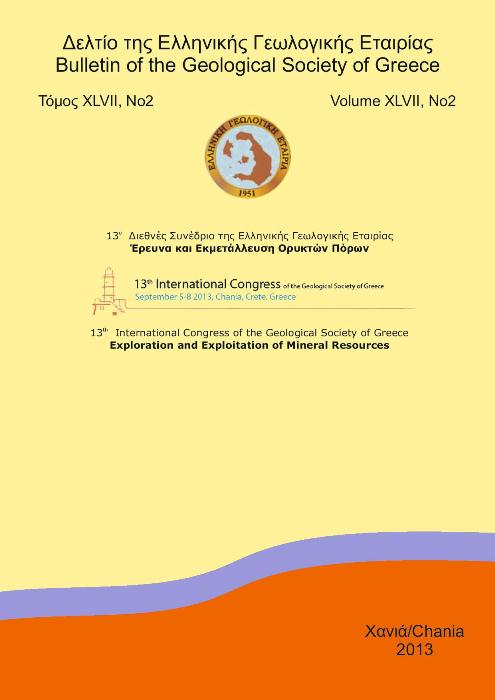Application for source parameters calculations as input for static stress changes studies

Περίληψη
Για τον υπολογισμό των μεταβολών των τάσεων Coulomb σε μία περιοχή χρειάζονται αρκετές πληροφορίες οι οποίες αφορούν τη γεωμετρία και την κινηματική των ρηγμάτων. Η συλλογή όλων αυτών των πληροφοριών οδηγεί σε μία σειρά υπολογισμών πολύπλοκων και χρονοβόρων κυρίως στην περίπτωση που η περιοχή μελέτης είναι ευρεία και τα υπάρχει μεγάλος όγκος δεδομένων. Σκοπός της παρούσας εργασίας είναι η απλοποίηση και αυτοματοποίηση των υπολογισμών που συνδέονται τόσο με τις μεταβολές της τάσης Coulomb που οφείλεται στη σεισμική ολίσθηση όσο και με την τεκτονική φόρτιση των σημαντικότερων ενεργών ρηγμάτων και εφαρμόσθηκε για την ευρύτερη περιοχή του Αιγαίου. Η εφαρμογή "Coulomb Stress Application" αποτελεί ένα χρήσιμο εργαλείο το οποίο παρέχει τη δυνατότητα στον χρήστη να εισάγει τα απαραίτητα δεδομένα για την εκτίμηση της εξέλιξης του πεδίου των τάσεων σε μία περιοχή. Πιο συγκεκριμένα τα στάδια που ακολουθούνται κατά την εφαρμογή του εργαλείου αυτού περιληπτικά είναι: α) Συλλογή δεδομένων για τους σεισμούς που μας ενδιαφέρουν και για τις παραμέτρους των ρηγμάτων, β) Υπολογισμός παραμέτρων όπως το μήκος του ρήγματος, το πλάτος του και η σεισμική ολίσθηση ενός ρήγματος χρησιμοποιώντας εμπειρικές σχέσεις και γ) Εκτέλεση όλων των απαραίτητων προγραμμάτων (π.χ. dis3dop.exe, GMT package) ώστε τελικά να κατασκευασθούν χάρτες με τις μεταβολές των τάσεων Coulomb. Η εφαρμογή αποτελεί μία μέθοδο απεικόνισης όλων των διαδικασιών που απαιτούνται για τον υπολογισμό των τάσεων, ενώ ταυτόχρονα παρέχεται η δυνατότητα εξέτασης των αποτελεσμάτων διότι προβάλλονται χάρτες με διάφορους συνδυασμούς δεδομένων.
Λεπτομέρειες άρθρου
- Πώς να δημιουργήσετε Αναφορές
-
Paradisopoulou, P. M., Papadimitriou, E. E., Karakostas, V. G., & Kilias, A. (2007). Application for source parameters calculations as input for static stress changes studies. Δελτίο της Ελληνικής Γεωλογικής Εταιρείας, 40(4), 2008–2019. https://doi.org/10.12681/bgsg.17294
- Ενότητα
- New Technologies in Geophysical and Geological Research

Αυτή η εργασία είναι αδειοδοτημένη υπό το CC Αναφορά Δημιουργού – Μη Εμπορική Χρήση 4.0.
Οι συγγραφείς θα πρέπει να είναι σύμφωνοι με τα παρακάτω: Οι συγγραφείς των άρθρων που δημοσιεύονται στο περιοδικό διατηρούν τα δικαιώματα πνευματικής ιδιοκτησίας επί των άρθρων τους, δίνοντας στο περιοδικό το δικαίωμα της πρώτης δημοσίευσης. Άρθρα που δημοσιεύονται στο περιοδικό διατίθενται με άδεια Creative Commons 4.0 Non Commercial και σύμφωνα με την οποία μπορούν να χρησιμοποιούνται ελεύθερα, με αναφορά στο/στη συγγραφέα και στην πρώτη δημοσίευση για μη κερδοσκοπικούς σκοπούς. Οι συγγραφείς μπορούν να: Μοιραστούν — αντιγράψουν και αναδιανέμουν το υλικό με κάθε μέσο και τρόπο, Προσαρμόσουν — αναμείξουν, τροποποιήσουν και δημιουργήσουν πάνω στο υλικό.








